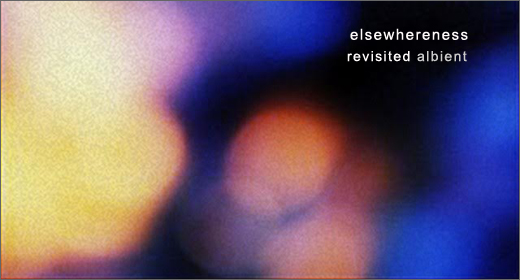Elsewhereness revisited is an occasional feature documenting the drift at the margins: ambient gasbagging and blurb blah, ’tube-d, ’cloud-ed, ‘n’ ’camp-ed up, complete with companion mix, Elsewhereness revisited #14.
Past Inside The Present keeps on presenting, latest, Low Priest, a second from Aaron Hansen’s Erinome after A Burning Down. Both immersive and vaporous, drawing multiple layers of guitar and field manipulations into a wall of sound, its organic intensity invites lostness. A thick fog is thrown up, though tone colors glint through, sounding deep into (un)consciousness. “Low Priest I” fuses field recordings, chimes and oscillating drone waves, throbbing, cascading, threatening descent into noise or collapse under its own weight. Rafael Anton Irisarri’s master-y brings out the filigree in “Low Priest II,” separate from a darker texture, affording a balance between wall and layers, allowing sounds space to co-exist. Japanese sound artist, Duenn, dealer in long-form works using minimal sources and gear with previous on Line, White Paddy Mountain and Entr’acte inter alia, offers Pattern—two reflective tracts extending to an hour of slow-burn shimmer and haze. Randall Taylor’s tape manipulation, field recordings and instrumentation of Amulets captures something of the ambience of the W. Oregon Coast in the ambivalentine daze of Streaking Light | The Lowest Tide. And a PITP debut from Kyiv’s Oleksiy Sakevych with the angelic Moments We Spent Together | Marigold Fields, echoing delight in the celestial transcendence and languorous yearning of Endless Melancholy‘s synth swells.
Remnants Vol. VI, latest installment in Isaac Helsen‘s slow release decon-recon project, is both portrait of the artist’s struggles with mental health (50% of proceeds go to mental health charity, Active Minds) and an ongoing critique of the ‘album’ concept. ‘Vol. VI context and setting: Cold air permeates earth and skin. Frozen in time and place, no movement, no body.’ Further worthies: Healing Sounds: A Compilation for Hurricane Recovery—dedicated to Hurricane Dorian victims, proceeds going to Int. Red Cross Bahamas branch—includes PITP roster men (36, James Bernard, Wayne Robert Thomas, Tyresta + zakè, et al.) plus likeminds (Olan Mill, The Green Kingdon, Black Swan, etc.). Then Sean Curtis Patrick‘s The Best Driving Music in the World Ever, sprung from a bout of depression that struck one evening, reflection yielding insight into the positive potential of loneliness—here a resolve not to leave the house till the work was done. Now presented as a fifth entry to his ‘canon,’ its sad-happy cadences draw you in to a zone of its own; proceeds to solar-powered futures enterprise, Honnold Foundation. Last, modular/non-modular synthesis, electronics and field sounds from Lyon’s PGD/MV, whose Morvan‘s ‘moody and cinematic improvisations […] cover a wide breadth of textures and emotional landscapes. Mechanical drones, feedback, and static build and eventually collapse into spacious and subaquatic ambiance.’
Purveyors of ambient and postclassical refinement, A Winged Victory for the Sullen, return with a fifth. Their ideas on spiritual influences drawn on to shape their work were informed by Hilma af Klint, the recurrence of the perfect 5th, inter alia. The artist belonged to “The Five,” a circle of five women with a shared belief in contact with spirits, often by way of séances. This chimed with the pair’s approach to collaboration, prompting a return to their writing process centered round the eponymous numeral; the five senses, the divine interval—hence The Undivided Five. It sees Adam Wiltzie and Dustin O’Halloran embrace the serendipity of the number, extending their ambient and neo-classical foundations, paying greater heed to smaller sonic details—perhaps further signaled by an unlikely move to Ninja Tune. The start of recording was marred by the death of a close friend; within weeks after the funeral O’Halloran learned his first child was on the way, soon after which a visit to see af Klint’s art brought a profound realization of life, death, the afterlife, and the spaces in between. The set was also shaped by the breadth of locations of its production, which assisted formation of its sonic nuance.
Tony Obr aka tsone sent three album demos to Ian Hawgood’s now defunct Nomadic Kids Republic in 2012. Pagan Oceans I, II, III came in when Hawgood still lived in Japan a year after the Tōhoku earthquake—time of great loss for his family and a tumultuous period as he sought to look after them across geographical and temporal distance. Pagan Oceans became a companion on those flights and journeys. The masters were worked on using an old Studer A80, all three finally mixed on reels directly before being transferred back across. The process of getting such richly textured analog ambient just right for the project took some time, with new reels needing to be sent periodically to Japan. Out now on Hawgood’s Home Normal, it’s a perfect marker to the end of the 10-year anniversary of a label whose founding byline invoked ‘unique organic minimalism’ residing in a ‘home’ that was timeless and beyond simple definition. Subtle, melodic, textural, possessed of a lightness of spirit, the set is both a label highlight and an exhibit of Obr’s keen musicality and sleight of sound-sculpting hand. And the forthcoming No Voices started from the humblest of beginnings—as a pile of old tape in Hawgood’s garage. Attempts to salvage what he could led to the slow disintegration of his reel-to-reel, which gradually slowed before giving up the ghost. Like Basinski and his loops, he found this to be good, as, with the collusion of sometime Slaapwel supremo, Stijn Hüwels‘ subtle melodies, the salvaged material made for some mighty mellifluous minimalism.
An update on Lee Norris‘s …TXT reveals two new objects of possible desire. After the oceanic allure of the recent Always There (see ER #13), Motionfield revisits Luftrum (Carpe Sonum, 2015) to draw on its IDM-electronica elements for A Clear Horizon. Behind the title is an anecdote-cum-quote from Hitchcock, whose definition of happiness was ‘A clear horizon—nothing to worry about on your plate, only things that are creative and not destructive,’ pointing to removal of negative energy and emotion to free up a pathway for creativity. Petter Friberg bids us go beyond to embrace a sense of flow, effacing time and space in an engaging work uniting hypnotic patterns, drifting synthscapes, subtle melody and evolving loops. In adjacent territory is Field Tangents from Off Land, Tim Dwyer’s latest ‘beatless, seamless, ambient kaleidoscope’ merging live performance audio with studio sessions sprinkled with miscellaneous field recordings to create something sui generis yet familiar. ‘Richly melodic and eerily emotive, […] transports the listener to a prism outside of space and time.’
‘Every portrait that is painted with feeling is a portrait of the artist, not of the sitter.’ The sole distinguishing feature of low profile London ambienteer oliviaway‘s bandcamp page is this enigmatic tagline. That and the startling volume of output over the last 2-3 years, even more noteworthy as the whole oliviaway discography—all 150 of them—is available with a 90% saving incl. unlimited streaming via free Bandcamp app, plus high-quality downloads of /DUST, i’m dissolving in you, confused thoughts, Silent Sky, ” shine to extinguish, MORE THAN JUST A DREAM., sweet tears, novella, and 142 more!! (my !!s). Lovely stuff and, from more than cursory sampling, not a dud in earshot, July’s Blurred/in motion particularly piquant ear-wise.
Shimmering Moods update: Robert Heel‘s The King of Groves, apparently inspired by Ossian Poems, a cycle of epic gaelic poems by James Macpherson, claimed as word-of-mouth material from ancient sources in Scots Gaelic collected and translated by him; but it’s believed they were fragments of poems and stories found by him and recontextualized into a romance of his own. Its dub techno inflections, albeit at the slo-mo atmo end of the spectrum, are a departure from standard issue SM. And out of Abruzzo (IT) comes Ten Atmospheres with the artful diverse mystical ambient Lulu Land, which includes “Color blue,” a dark scintillating Fourth World river, “Midnight Mood” evoking the night’s wonder, and “On my Way” with (Vladislav) delay echoes. And Essen mysterion, WhoIsIR, whose Into the Void came from unassuming beginnings in a night of experimenting with synths and samples creating the foundation of the first part, little knowing it would be the start of a debut album. Two days later he heard his father had passed away around the time he’d been in the studio producing that first part, having decided to end it all after years of depression. Retrospective listening revealed a floating quality to the music, as if a soundtrack to a transition to another dimension. Having used it to help deal with the grief, he decided to make it his debut album, dedicated to his father. It evokes not only sadness and loss but also hope and relief. One beatless “Into the Void”, one technofied iteration and a mixed-mode reiteration.
Abul Mogard finds a new application for his modular synths, Farfisa organ and field recordings in soundtracking Duncan Whitley‘s film, Kimberlin. While the sounds on Kimberlin are in line with previous works—a forlorn feeling of isolation or a hidden, secret place. but with less of a foggy, mysterious tone with slightly fuzzy edges, more ing into somewhat bleaker realms. Mogard offsets the barren stony landscape of a small isolated island, the apparent discovery of an underground cinema cavern on the Isle of Portland, against a backdrop of fizzing drone and inward-falling shoegaze. The local word for outsider/foreigner, ‘Kimberlin’ was filmed on location in the months after the 2016 referendum which led to our current parlous state. It does service as a metaphor for the isolationist mood of an increasingly inward-looking state, and our often desolate mental states, reflecting a sense of (be)longing and outsider loneliness perhaps mirroring the putative collective feeling since that darkly historic vote three years back. It opens out with a slow-burn greyscale iridescence, gently manipulating fog horns and bird calls in briny modular spray and gloaming Farfisa organ swells. With titles like ‘Flooding Tide’ and ‘Playing On The Stones’, it semiotically mirrors the film’s subject matter, echoes in the digital future of a country now hard to grasp, hauntingly re-contextualizing Cecil Durston’s description of Portland—where ‘quarry bells no longer ring, except in old men’s dreams’—to the endless conundrum of Brexit and its generational devastation. Ecstatic vinyl.
After a few years’ hiatus Glacial Movements‘ artistic director, Alessandro Tedeschi aka Netherworld, is back with Algida Bellezza. Alchemy of Ice (2013) signaled something of a landmark in his recording career, followed by Zastrugi (2015) and Himuro (2017) with Eraldo Bernocchi. On the back of the birth of his daughter in November 2015, it’s dedicated to her, the soundscapes being composed mainly during the night while she was cradled in Papa’s arms, using only one instrument—the Roland VP9000 connected with a multi-effect rack. Titles invoke various arctic species: Vulpes lagopus (arctic fox), somniosus microcephalus (Greenland Shark), orcinus orca (Orca), monodon monoceros (narwhal) and ursus maritimus (polar bear). A parallel perhaps between the beauty, innocence and fragility of a newborn baby girl and that of the flora and fauna of the fragile Arctic ecosystems.
Berlin’s Vaagner/Vaknar have several September releases. Themes For A Better Tomorrow Vol. I ‘In Full Bloom’ sees Shuta Yasukochi readapt the nature-themed formula of previous works, both sonically and nominally, while expanding on it by presenting the album in a story-like arc that slowly unfolds throughout. Thus, most aptly experienced in its entirety for its its narrative and meditative properties to take effect as you’re slowly enveloped in its gracious ripples; glistening chimes and faint strings quietly emerge from layers of reflective ambiance. Then, there’s Cathedral Pines from Rochester, NY native, Joseph Lawerence Clark, who, having quietly self-released a handful of works, proposes a compelling set of immersive tableaux using looped guitars, violin and synths processed through various samplers and pedals (many built through his own Adventure Audio).
Infinite Tape Loops Vol.1 is identified by some as bringing to mind Basinski‘s Disintegration Loops—a facile reference point, which for all its accuracy would content only those content with the facile. Though first released at the end of last year, recent viyle reissue is what warrants mention now—plus it may have eluded you then. Andrea Porcu‘s Music for Sleep project has been quietly going about its business for a few years now, and ITL Vol.1 is a perfect distillation of its essence: each piece revolves around a short melodic loop that plays throughout, strings and pad harmonization filling the gaps with a gentle tapestry of long diluted sounds, becoming the primary element. Timbral variation, amplitude automation and gradual filtering, get the flow going, bringing changes to the ground-figure relations of the two main sound actors. This floating/heavy sound is lightly elevated into sounds that become grounded in appearance and disappearance, underlying a static, unchanging landscape.
Chihei Hatakeyama‘s Forgotten Hill on Room40 draws inspiration from a trip to the Asuka region, experience of which became a compositional guide to his set of sonic impressions. Once home to Japan’s capital, faded and decayed, it’s now a little-loved rice-filled rural area, open fields scattered with burial grounds and other emblems of loss, the album seems to reflect a certain sense of degeneration in short subliminal pieces that never peak, signature tones enshrouding, spiraling into slow effervescence. Titles contextualize Hatakeyama’s inspiration, the likes of “Staring at the Mountain” and “Buddha Statue Without Roof” lending a sketch-like quality in which the compositions function more as fleeting feelings than fine-tuned statements. The record speaks of time, of losing direction in it and wondering where exactly and under what circumstances past, present and future might meet. There’s also Ghost Woods on his own White Paddy Mountain, after the fictional forest in David Lynch’s ‘Twin Peaks,’ The black lodge located on the border between Canada and the US inspiring the author ‘after receiving many imaginations’ articulated in long-form ambient drone style, which as the album takes its course evokes the vast depths of a mysterious forest.
Still in Room40, we find (relative) old-timer, Yann Novak, and new kid on the exp-drone block, Ian Wellman. With Bioaccumulation, following last year’s Susan’s Last Breath Became the Chill in the Air and the Fog Over the City’s Night Sky (Dragon’s Eye), LA-based field recordist/composer Wellman creates an evocative assembly of ambient sound fields, drawn from the Sierra Nevadas. His shtick—‘merging the experienced and the imagined worlds, he realises dense folding sonic textures that evolve to create an otherworldly but utterly consuming acoustic portrait.’ Titular reference is to accumulation of toxic substances in the environment when an organism absorbs a substance faster than it can lose in catabolism or excretion, a process only magnifying as it moves down the chain. The concept started with the idea of sounds cycling and mingling together, eventually attacking one another or disintegrating, our relation with nature mirrored in this endless cycle of extracting and depleting resources. Field recordings serve as active artefacts of our effect on our environs, human-generated sounds reflecting the incessant noise pollution contributed to the world. Elsewhere with Slowly Dismantling, Yann Novak problematises understandings of ambience as homogenous and static, deconstructing it, ‘pulling its way from the blank and the atmospheric, refusing the perceived luxury of sound within which context is erased.’ Reflecting on formative experiences as a queer youth in middle America, he explores the idea of these acoustic and social spaces as zones of liberation within which a spectrum of identity is formed via a series of dense sonic fields that reflect on how the past can be decoded and deployed as a device for contextualizing the future.
Two-thirds of US drone trio, Hotel Neon, brothers Michael and Andrew Tasselmyer, give their Gray Acres vehicle another outing. Initially working independently, they build ideas, loops and recordings which are then realized into full tracks once they get down and F2F. Field captures from Asia, specially selected for their powerful intense character rushing water, thunderclaps and rock, provide a conceptual influence, and Material Forces became the name of the follow-up to last year’s Sound in Silence unveiling (sighted on ER #8). It’s a dense but physical drift-fest, at once tactile and lulling, much performed live with limited post-production. Harry Towell’s Whitelabrecs hosts. While we’re here, note the Hotel curators have done the right thing and given a proper release to Relic, a tape made for their recent European tour with Simon Scott and Marcus Fischer.
Keith Berry‘s Viable Systems 2 is a ‘Generative Music’ album based on ‘a system put in place and let run to produce music’. Following Viable Systems 1, its selections are captured moments that could theoretically last forever. In line more conceptually than sonically with Eno’s generative experiments, its synth sounds are somewhat sharper, faux-analog in feel, light in atmosphere. Berry quoth: ‘I like to think what I do is akin to a small seed that, given the right conditions, can grow into something far bigger than the work itself, a “trigger” which though does not contain enough information in itself to impart enlightenment, may possibly be sufficient to unlock the mechanisms inside one’s mind that leads to enlightenment.’ VSM Theory is a new imprint founded by Berry, whose main interest lies in generative process-derived works retaining the principal qualities of incidental soundscapes. A complement to variable conditions, sweetly resonating tones afford the basic melodic fragments defining a given piece, underlying harmony shifting with the deliberate drift of heavy cloud. Ambient can feel somewhat bloodless stripped of imperfection, and rather than sounding smeared with something of its surroundings, this Berry feels somewhat artificially ripened.
First vinyl release from Canada’s Polar Seas features Greig Baird, whose Moss Covered Technology has been active since 2016. Slow Walking is a set of shimmering synth floated over oceanic backdrops. Bristling with lush synthetic ambience, texture and attention to detail which makes for a deep and rewarding listen. On more stripped back pieces sparse melodics bubble ground level as warm swathes swell to figure. This walk affords the pleasures of the text, a deep dive with freedom to bring your own pearls to surface. Sometimes a fizz of particulate detail,—as if of sparks of minimal guitar, illumines ‘scapes and perambulation through them. ‘Somewhere at a cross between early Edgar Froese, Ashra, Harold Budd, Bass Communion, and Machinefabriek,’ says notre ami, Philippe, in a recent ‘gloo-view. Required listening on your own private dérive.
Kindred spirits in music therapy and nature signifiers, Alex Smalley and Angela Klimek each offer new carriers of healing. Olan Mill‘s Sacred Geometry is split in two, part based on live performance with guitar, synth, voice and field recordings at 2018’s Le Guess Who? festival, part blending electronic and acoustic instrumentation, though sound sources become otiose, drawn out as they are in droney convergence. Mastered by another stable fave, Porya Hatami, and hosted by Dronarivm. And a year on from Moments in Golden Light, poemme brings a new set, Frozen Passages (Stereoscenic), ‘an imagined journey into the far north of the continent, through boreal forest, across vast, barren landscape, through the iciest storm, and eventually finding warm refuge as the night brings a welcome calm to the tundra.’ Companions in the story are the birds of the air in all of their diverse colors and forms, represented in many of these soundscapes by woodwind and distant flute flourishes, evoking their calls. You get ‘a balance of snowy, frost-covered dreamscapes, inspired by the beauty of nature, and tempered with the warmth of human emotion.’
Berlin-based electronicist Hainbach, previously on Opal Tapes, Spring Break Tapes, Limited Interest, and Lavender Sweep, is hosted by Frankfurt’s Seil for his latest Gestures. Trailed as ‘an album of disappearing and acceptance,’ a sense of loss offset by interleaved piano motifs, oscillator-harmonized, fragile and half-broken, ‘gentle movements above radio antennas guided the recording process, adding an incorporeal, dreamlike feel,’ Stefan Paul Goetsch creates shifting audio-scapes with an organic-not-organic earfeel, rich in micro-textural detail like sonic moss. Like a piano recital hijacked into a face-off between neo-New Age Eno-esque minimalism vs. Basinskian loop decay.
Last exit: Definitely the most satisfying Maps & Diagrams in some time from Tim ‘I prefer to remain a mystery’ Diagram, Ottava artfully connects the dots of his previous work from drifty ambient drone-y through more Out There sound design to Atlantidean DIY electronics. On Handstitched*, natch. The seventh release from Tapes and Topographies on his own Simulacra imprint finds Todd Gautreau with a further refinement of the spotty elegance of his sad-happy sound on Ubiquitous Clouds. Michiru Aoyama has a slew of releases out on Japanese imprint, Bullflat3.8—presumably his own as it features his music almost exclusively, most recent being Zero and Edge. Evergreen Avenue‘s bandcamp page is full of free floaty drifty head gear, with August’s Abstractions of Breath a perfect exhibit of the breadth of his ‘Infinite soundtracks.’
Late entry: UK label, Neotantra, brings Colombian ambienteer, Bålsam, with Soul Offerings, a deep meditative album of beautifully woven textures and field recordings, infused with haunting slow-mo melodies.


















![Allmanna Town :: 1911 EP (Self Released) — [concise]](https://igloomag.com/wp/wp-content/uploads/2025/03/allmannatown-1911_feat2-75x75.jpg)



